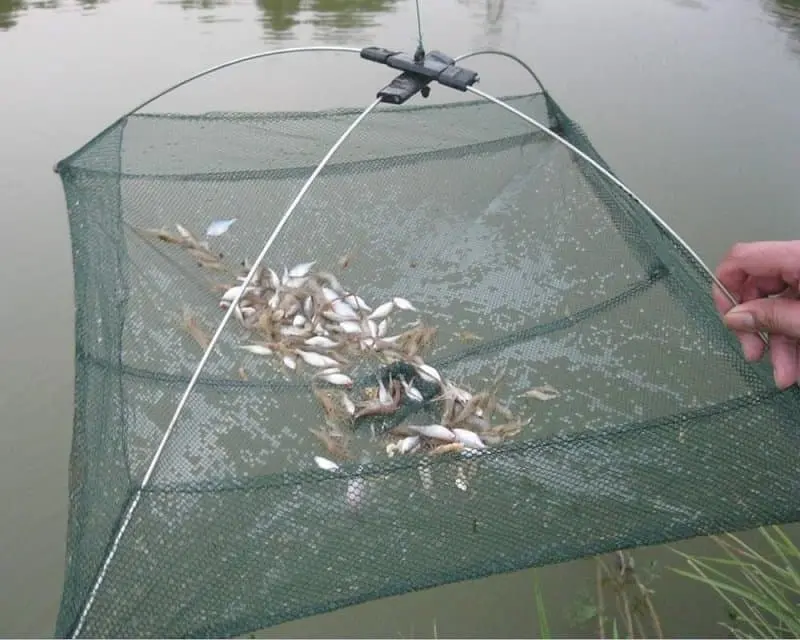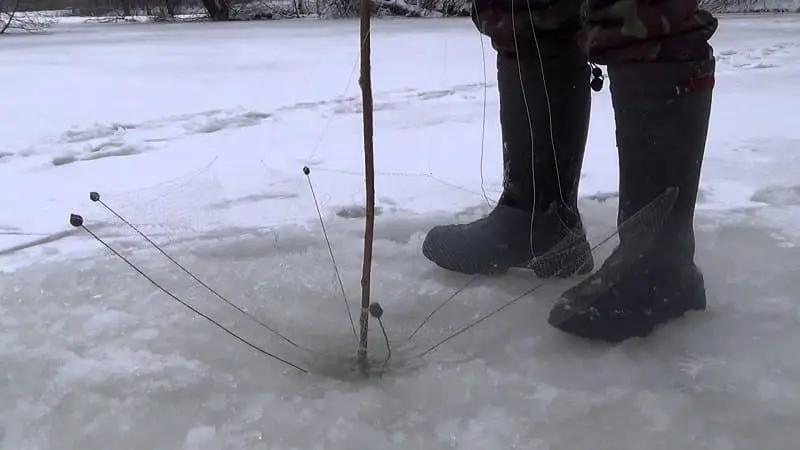Contents
A fishing spider is a very simple device for catching fish, perhaps only easier to use. Previously, it consisted of metal rods, now metal-plastic, plastic rods, etc. are used. These rods are fixed in the cross, and a network is pulled between their ends.
Spider species
Spiders are divided into several types depending on the design features and type of application:
- Classic square.
- More advanced “brother” – hexagonal.
- Crayfish spiders, four- and six-sided.
Ordinary, for fishing in the summer
For catching fish in the summer, an ordinary four-sided lifting spider is most often used. The reason is its ease of use. In addition, such a design is so simple that with a grid and 4 rods (4 rods are easier to find than 6), it is not difficult to assemble the structure. Lure is placed in the net, the fish is going to feed, the fisherman pulls and he folds and pulls the catch.
For winter fishing
Winter fishing is not much different from summer fishing. The only feature is the selection of a drill for wider holes, so that the spider easily enters and exits the hole. The bait is placed in the center of the spider, and it sinks to the bottom, it “opens up”, the fish feeds, the fisherman picks up the spider, it folds, and the fisherman takes it out of the hole already with the fish.
Large size spiders
Naturally, the larger the size of the spider, the higher the potential catch. Therefore, many fishermen have a weakness for large products, but it should be noted that the larger the size, the more physically difficult it is to lift the device out of the water. The largest spiders use fishing boats, but there is a special lifting mechanism. In some countries, small spiders are allowed to be fished, and large ones are considered a poaching device. Therefore, before using this tackle for fishing, study the legislation of your country on fishing. Being carried away by the sizes, do not break laws and common sense. A large product is usually fished from a boat, so there will be more convenience for the angler.

Best Spider Fishing Spots
The best places are thickets of reeds (naturally, next to thickets of reeds – you can’t throw a spider into the thickets themselves and don’t “drown”) and places near trees growing in a pond.
Technique of use
You need to be able to use this wonderful tackle in every sense. The technique of its application is divided into several types, although in essence they are all quite similar.
- From the shore. In this case, the fisherman fixes the spider on a strong base, which is often used as a shaft or the trunk of a small tree. A spider is tied to it and thrown into the water. In some ways, this device will look like a fishing rod, but instead of fishing line, a rope is used, and instead of a rod, a thick shaft.
- From a bridge or pier. The fisherman can use “lever” devices when the railing of a bridge or wharf acts as a fulcrum. In this case, you can use a larger spider. Otherwise, this one is extremely similar to the technique of fishing with a spider from the shore.
- In winter. As mentioned above, it is impossible to use a large spider in winter. The reason is the size of the hole. A spider for winter fishing should be small, no larger than a hole that your drill can make. Otherwise, it will be impossible to get the catch out of the water.
Self-made spider
Materials and Tools
- Metal pipes, preferably light metal. Ideal for aluminum.
- Metal tube for the cross.
- A fishing net that is pulled over a structure.
- Rope (pulling a lift on a fishing line is extremely problematic).
- Strong handle (in the villages, a shaft was used as standard).
- Hacksaw and hammer.
- The most problematic and expensive assembly tool is the welding machine.
- Schemes and drawings.
Manufacturing and assembly technology
Everyone will be able to make a homemade spider, the main desire and a little ingenuity.
- First, a cross is made. In order to flatten the pipes, you need a hammer. Next, using a welding machine, we fasten the pipes perpendicularly by welding. Welding will also be required to weld a ring to the cross, to which a rope will be tied to lift the spider and immerse it in water.
- The second stage – using a hacksaw, we make notches on aluminum arcs for tight fastening of the fishing net. Of course, the arcs themselves must fit very tightly to the structure.
- The third stage is the fastening of the grid. It must be fixed in such a way that it sags slightly, otherwise if the net is simply stretched, the fish will easily leave your tackle. But the net should just hang down a little, since the larger the net, the harder it is to get the spider out of the reservoir, especially with the catch.
- When the metal rods entered the cross and the structure was assembled, a rope must be fixed on the ring of the cross, and its other end securely attached to the shaft so as not to miss the spider. For these purposes, at the place of attachment to the shaft, a path is machined with a knife. Thus, the rope is kept not only on the knot, but also, as it were, “bites” into the tree.

Spider catching fine
Catching a spider in the Russian Federation is not prohibited if the size of the tackle does not exceed 1×1 m. A larger spider is considered a poaching device, and a fine of 2000 rubles may be imposed for its use. You can also get a fine when catching certain types of fish for spawning, if fishing for them is prohibited in your area during this period.
Of course, it is forbidden to fish for a large spider, which cannot be lifted by a person on their own, and transport and mechanisms are used to lift it. Such a violation is set out in Article 256, paragraph “B”: “Illegal extraction (catch) of aquatic biological resources using a self-propelled floating vehicle or explosives and chemicals, electric current or other methods of mass extermination of these aquatic animals and plants.”
Also, under this article, you can fall under criminal liability when catching fish even with a 1×1 m spider at the time of spawning (paragraph “B”): “in spawning areas or on migratory routes to them.”
Therefore, it is necessary to use this device for fishing with an eye to the laws in order to enjoy fishing, and not fines and other unpleasant consequences.









